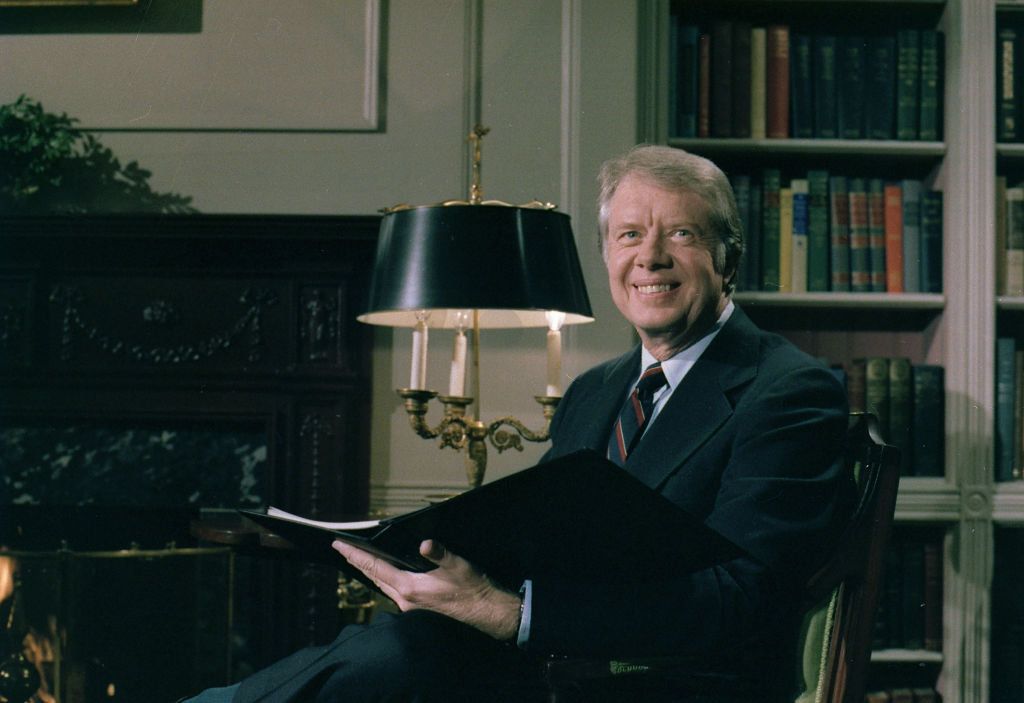President James Earl Carter served as the U.S. President from 1977 to 1981 and is a Naval Academy graduate who turned 100 today. Carter has a legacy of service and humanitarian efforts across the 20th and 21st centuries. His presidency dealt with many key events in world history such as the Camp David Accords, the Panama Canal Treaties, the second round of the Strategic Arms Limitation Talks, establishing the U.S. Department of Energy, the Iran Hostage crisis, the Three Mile Island accident, the Nicaraguan Revolution and when the Soviets invaded Afghanistan. He also led key follow-up events such as ending Détente, the Carter Doctrine and eventually boycotting the 1980 Summer Olympics in Moscow. Before his presidency, governorship and being a state senator in Georgia, President Carter attended the U.S. Naval Academy and served as a Naval Officer.

He grew up in Plains, Georgia, and attended the Plains High School until his graduation in 1941. He initially attended Georgia Southwestern College and then the Georgia Institute of Technology while being involved with ROTC. He received an appointment to the Naval Academy in 1943 and graduated with a BS in 1946. He met his wife Rosalyn Smith and they wed after he graduated from the Academy in 1946. They remained married until her passing on November 19, 2023. He was the 60th student out of the 821 midshipmen in his graduating class and was commissioned an Ensign. He served on active duty from 1946 to 1953 and then as a reservist from 1953 to 1961. He earned the following military awards: the American Campaign Medal, the World War II Victory Medal, the China Service Medal and the National Defense Service Medal. He was stationed across the US from 46 to 53 in Virginia, Hawaii, Connecticut, New York and California. He initially served on the USS Pomfret in 1948 and was promoted to Lieutenant Junior Grade in 1949.

President Carter performed duties on the USS Promfet until 1951 being assigned to the USS K-1 and then serving as the XO aboard the sub. In 1952 he was assigned to the Navy’s nuclear sub program. He was mentored by Captain Rickover, who oversaw the program and had a strong influence on Carter’s life. Carter then attended the Naval Reactor Branch of the Atomic Energy Commission for three months and on December 12, 1952, the experimental NRX reactor at the Atomic Energy of Canada’s Chalk River Labs partially melted down. Carter was on the Navy response team ordered to assist in shutting down the reactor. He was lowered into the reactor in protective gear for 90 seconds to limit nuclear exposure and help disarm the reactor. Carter’s role inside during his brief time in the reactor was to turn a screw. The reactor was thankfully disarmed through his and the rest of his team’s actions.

Carter’s Naval career continued to progress into 1953 and he attended a six-month nuclear power plant operation course and was planned to work on the USS Seawolf, the US’s second nuclear-powered sub. His life course altered when his father passed from pancreatic cancer just a couple of months before the USS Seawolf’s construction was going to start. He requested to be released from active duty and he transitioned to the reserves to take over his family’s peanut business. He faced many challenges during the transition to civilian life such as business debt settlements, the first year of his crop harvest failing from a drought and having to find several lines of credit for his family business in operation. His wife found the transition from active duty to civilian life challenging as well, especially when going back to a small town in Georiga.

Carter won a seat in Georgia as a State Senator from 1963 to 1971 as a Democrat. During this period he was a strong supporter of John F. Kennedy, ran against Bo Callaway for the House of Representatives, as a Georgia gubernatorial candidate in 1966 and 1970, and became the 76th governor of Georgia from 1971 until 1975. As the governor, he made the push to end racial discrimination and made the effort to streamline inefficiencies in state government. He made strides for Civil Rights in the state and continued to push for Democratic success in local and national elections. He made a bid for the President on December 12, 1974, by announcing his plan to run for President at the National Press Club in D.C. He competed and won against 16 other candidates in the primaries and then beat President Ford in the general election in November of 1976.

His Presidency from 1977 to 1981 involved taking over during a tumultuous period and righting the ship. The Vietnam War ended with a loss and a lot of economic issues being inherited by his administration. Carter did help calm issues around the globe with the Camp David Accords, returning the Panama Canal back to Panama for control, signing SALT II for nuclear arms reduction with Soviet Presidium of the Supreme Soviet Leonid Brezhnev and bailing out the Chrysler corporation with a $3.5B loan in 1980. He lost the election to Ronald Reagan in 1980 and returned to humanitarian work in his civilian life with the Carter Center, which he founded in 1982. The Carter Center is a non-governmental and non-profit focused on the advancement of human rights, improving the quality of life for people in 80 countries and works with the World Health Organization on many causes.


President Carter also did humanitarian work with Habitat for Humanity and helped build over 4,300 homes for build across the world. In his personal life, he enjoyed spending time with his wife and four children, serving people through his faith, fly fishing and playing tennis. He was a close friend of Elvis Presley, is the longest live former U.S. president and believes his longevity is because of having a good marriage. Happy 100th Birthday to President Carter!


